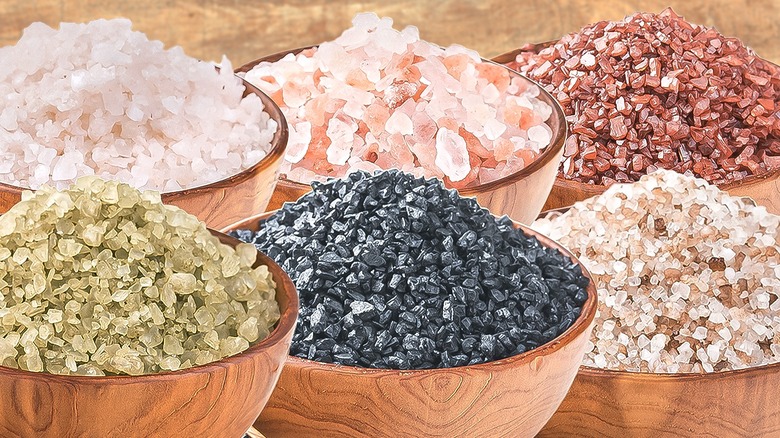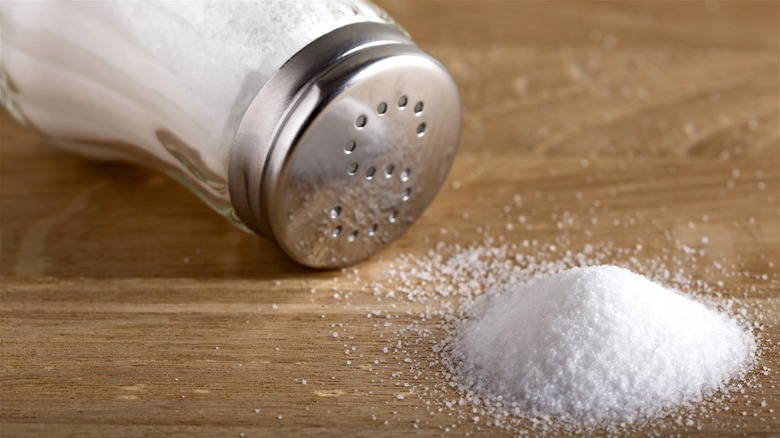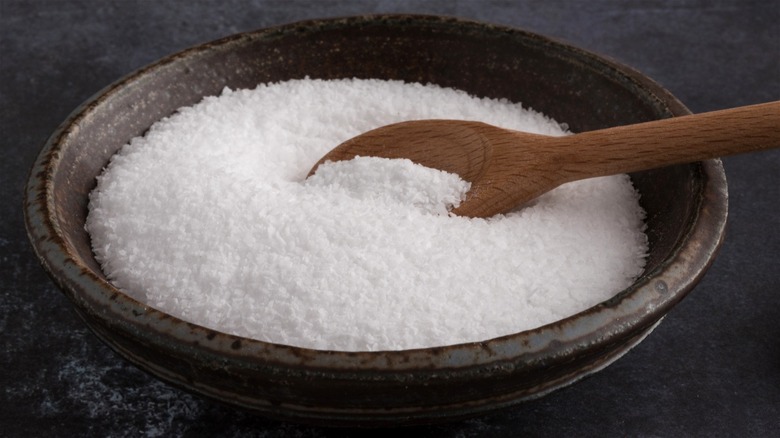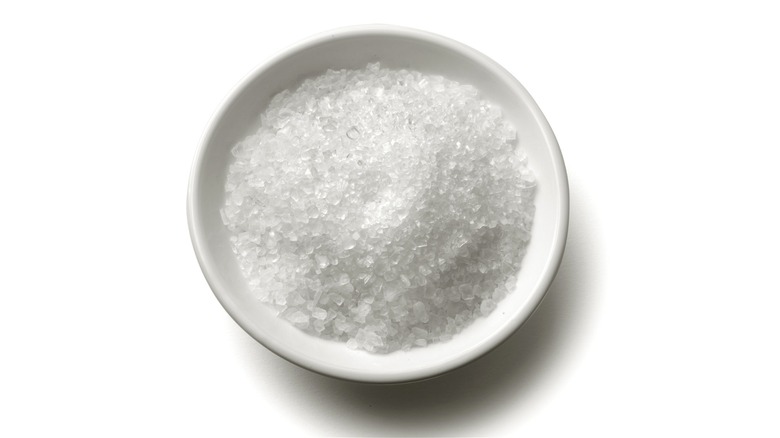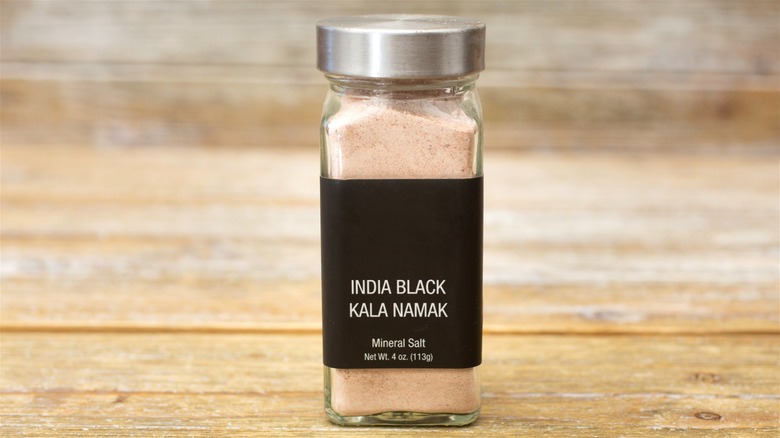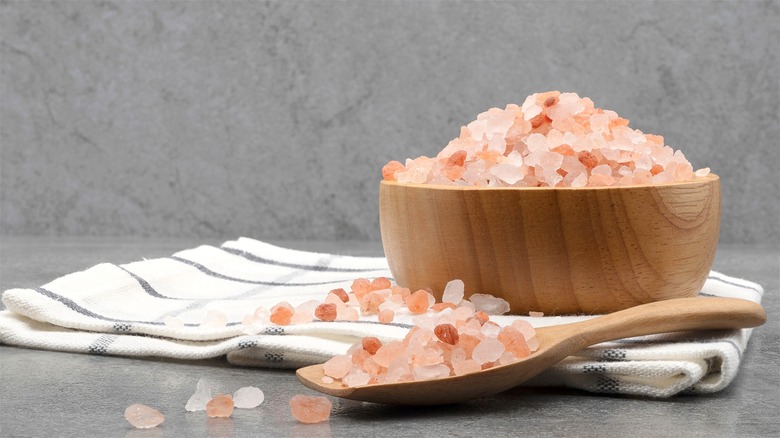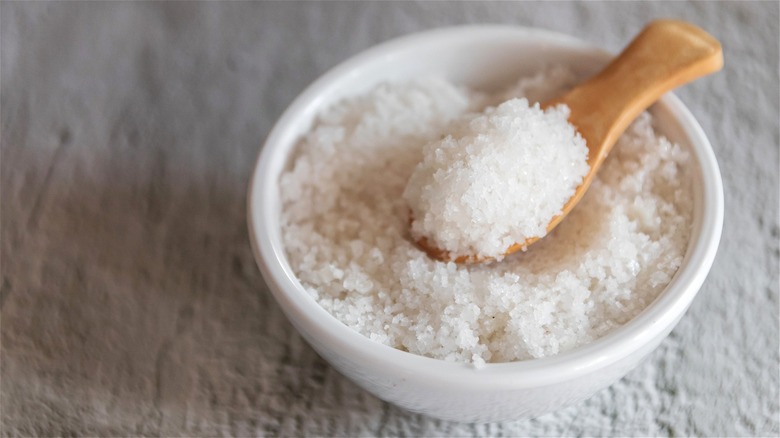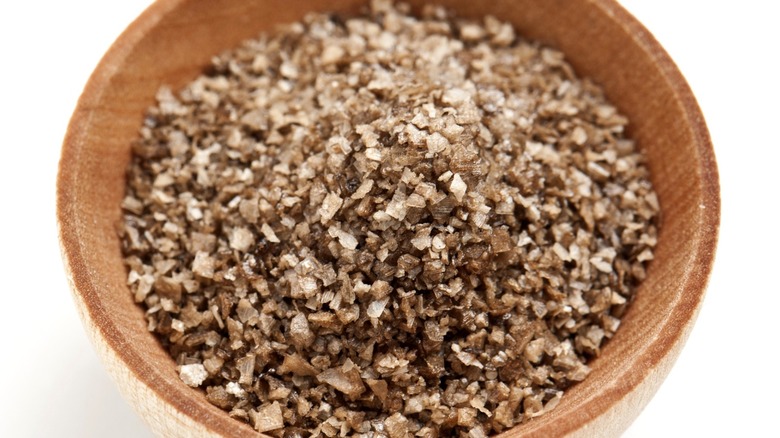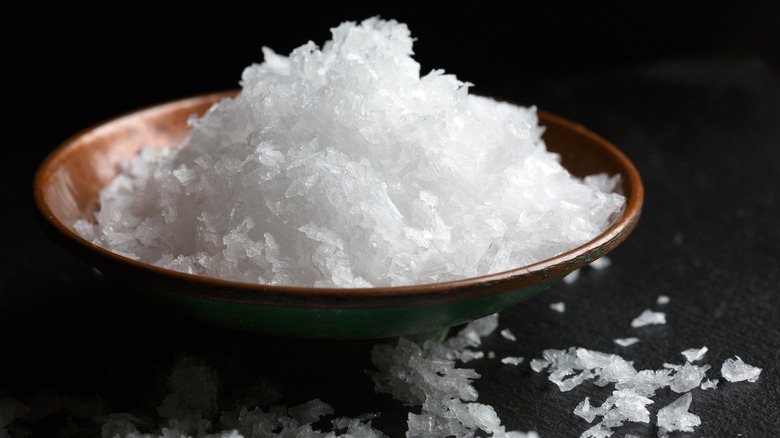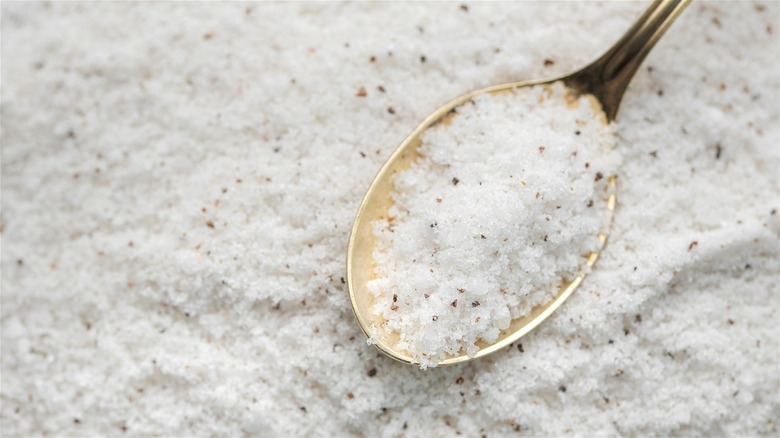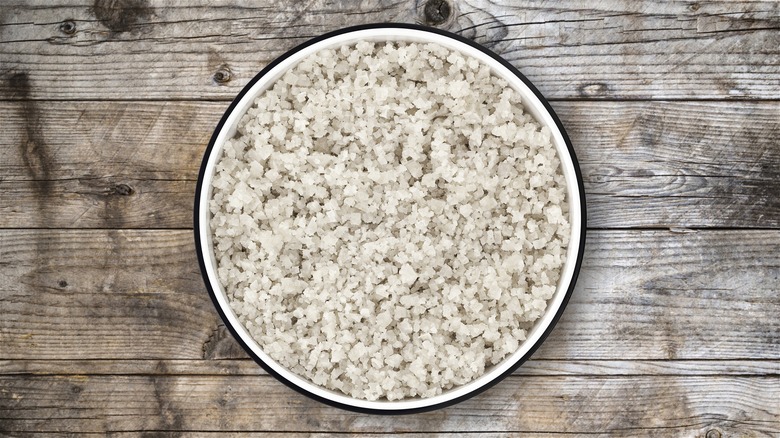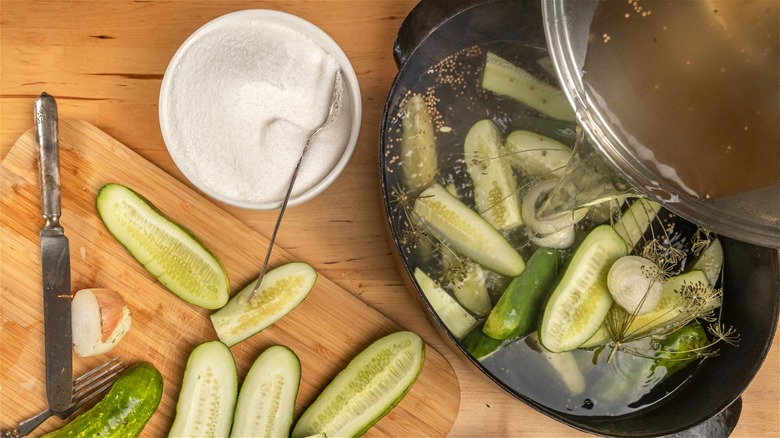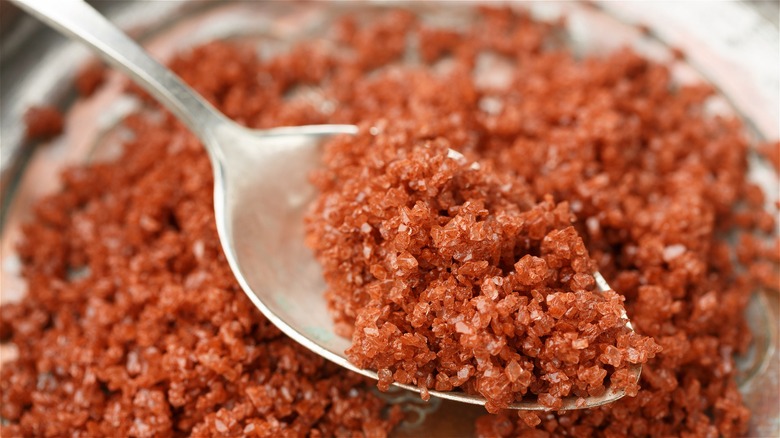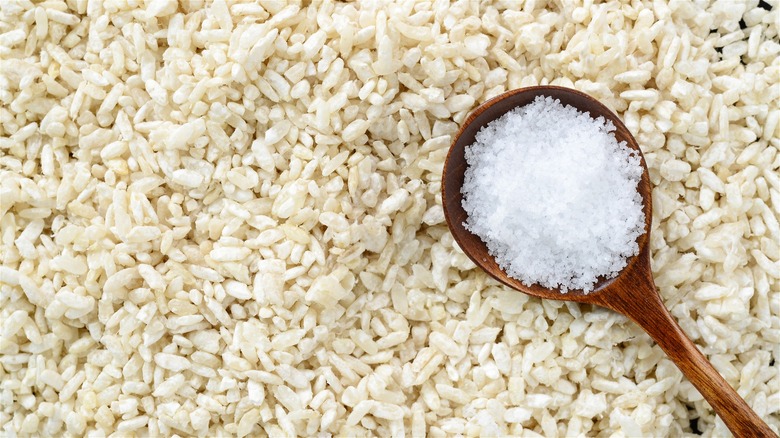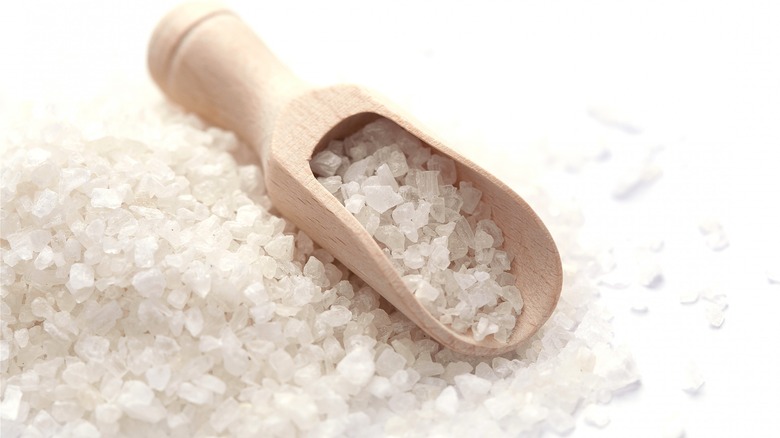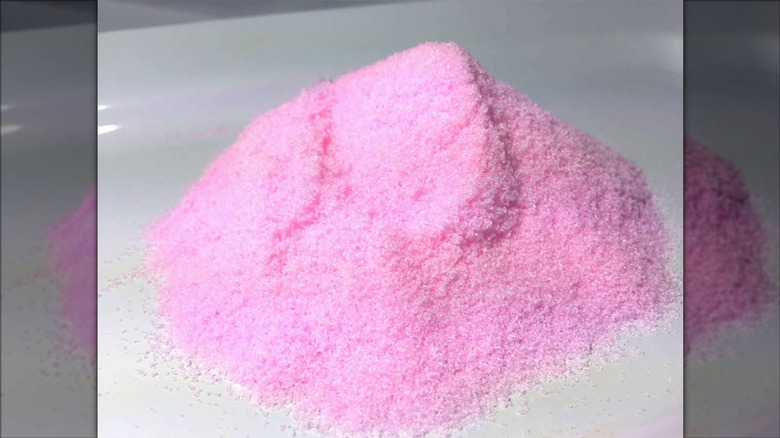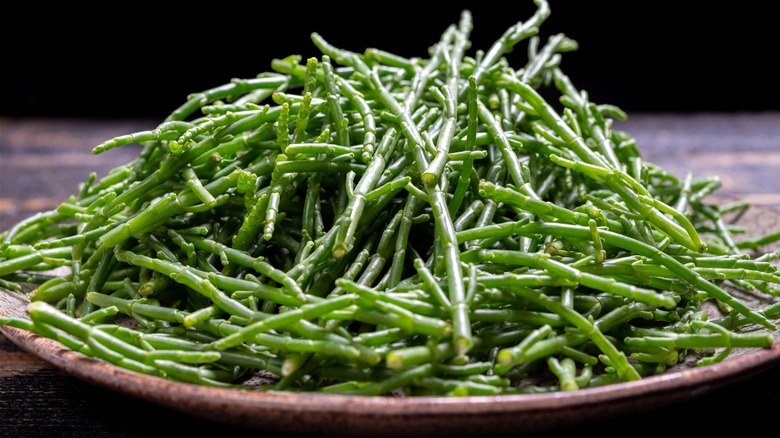16 Types Of Salt And How To Use Them
In the labyrinth that is modern cooking, salt is the thread that has led us through for centuries. It's a truly indispensable ingredient — not only is it absolutely necessary for human health and survival (provided it's consumed in adequate doses), but food wouldn't be the same without it. And if you think you already know everything about salt, think again. We are about to reveal over a dozen of its secret identities, each with a unique backstory and flavor profile.
This humble yet powerful ingredient can be a supporting act or the star of the show, a mere flavor enhancer, or a mesmerizing finishing touch. Cooking, baking, and preserving foods often wouldn't even be possible without it. Ever heard of saltless pickles? That's what we thought. From the familiar faces of table, kosher, and sea salt to the exotic allure of Hawaiian and Japanese salts and the gourmet elegance of French fleur de sel, get ready to know the extended salt family and its hidden powers.
Table salt
Table salt (often labeled as granulated or refined) is ubiquitous in kitchens around the globe yet far less universal than it seems. Harvested from the heart of underground salt deposits, it emerges as small, even-sized cubic crystals — dense and taking their sweet time to dissolve.
Its flavor profile is directly related to its industrious nature. There's a touch of metallic, thanks to potassium iodide and anti-caking agents such as magnesium carbonate or silicon dioxide. While ensuring the salt doesn't clump, these add-ins are why you should avoid using table salt in your pickles — they can leave a faintly bitter aftertaste and cloud the brines of your lovingly prepared preserves.
But there's a reason many baking recipes call for table salt. Its uniform granules make for easy, accurate measures that bolster gluten development, regulate yeast growth, and provide a consistency that's hard to beat. You'll also find it holding court at the dining table, ready to give a seasoning boost to any dish. And if you're out of fancy salts, table salt is your trusty pinch-hitter.
Kosher salt
Stemming from its role in the koshering process, where its coarse granules were sprinkled on freshly butchered meat to draw out blood, Kosher salt has found its place as a reliable staple in everyday cooking. However, the name alone doesn't make it automatically kosher-certified. Almost pure sodium chloride, it's birthed from the heart of rock salt deposits, boasting light yet coarse granules that are a favorite in both professional and home kitchens. The lack of iodine and anticaking agents, and a milder, less bitter flavor, make it a more versatile choice than table salt.
Kosher salt is revered for its "pinchability," or the way you can firmly grab onto its larger granules with your fingers without dropping any, and thus season food evenly. It's a key ingredient in all kinds of cooking and brining, able to both dissolve quickly and create an evenly charred texture on animal proteins. It even shines in mixology as the salt of choice for a cocktail rim. It's debatable whether it's suitable for baking, but it will do in a pinch.
Sea salt
The indispensable companion to both sweet and savory dishes, sea salt's versatility can't be underestimated. Judging by its name, you'd think its origin can always be traced back to evaporated seawater. However, "sea salt" doesn't always mean what you think, as the FDA focuses more on its purity than its actual provenance. Its texture can range from coarse to fine, with a crunchiness that trumps table and even kosher salt. The flavor profile? As varied as the sea itself, it oscillates depending on the harvest location, rendering each brand unique.
Its mellow, ocean-like flavor makes it an exquisite choice for salt rubs, marinades, and last-minute seasoning. It is also commonly used as an attractive topping to baked goods like pretzels and cookies. And yet its flavor isn't overpowering — a sprinkle here and there is subtly amplifying the natural flavors of food without stealing the spotlight. Sea salt typically isn't iodized but teems with natural vitamins and minerals, making it the salt of choice for fermentation.
Himalayan black salt
Meet kala namak, a volcanic rock salt from the Himalayan region. Its unique, almost egg-like, sulfurous aroma made this staple of Indian and Nepalese cuisines a favorite among plant-based enthusiasts worldwide. But what exactly is it? Well, it's rock salt that's been kept in a furnace with charcoal, herbs, and seeds to create a unique flavor. Although known as "black salt," its color is often ashy pink. The texture can vary greatly, from superfine to coarse (when sold in spice grinders).
While it's not a great substitute for regular salt and its applications are limited, when used correctly, its magic is palpable. It's the secret ingredient that will revolutionize your vegan cooking, particularly tofu scramble and other egg alternatives. Want to experiment further? Try making Nimbu Pani, the ultimate thirst-quenching drink, where its unique flavor dances beautifully with the citrus tang and the sweetness of sugar. But remember, with kala namak, a little goes a long way. Start with a conservative pinch and adjust to your liking.
Himalayan pink salt
Before you ask: No, it's not the same as its sibling, Himalayan black salt – they're two distinct flavors. Harvested from the rocky depths of Pakistan's Khewra Salt Mine, this delicate rock salt has had foodies and health enthusiasts of the world in a chokehold for years. The so-called impurities might sound off-putting, but they're the essence of its appeal — and its enchanting pink hue. It has a lower sodium chloride content and dozens of trace minerals to boot, but that doesn't make it much healthier than other salts, as the mineral concentration is too low to matter.
Pink salt's flavor is a complex symphony of minerals, far richer than the stripped-down table salt. Best used as a finishing flourish on popcorn or salad, it's also a competent player in brining and fermentation (if you can't get your hands on more moderately priced salts). And let's not forget the Himalayan salt slab: an exceptional tool for curing, cooking, and serving food that adds a dash of drama to your culinary endeavors.
Fleur de sel
In the realm of gourmet salts, fleur de sel (French for "flower of salt") reigns supreme. Hand-processed and sourced from the sun-kissed waters off the coast of Brittany, France, this salt is the epitome of elegance — with a hefty price tag. Its texture is a culinary paradox: moist yet gritty, delicate as a snowflake, yet potent enough to transform any dish. Fleur de sel teases the palate with a subtly briny, sometimes sweet flavor profile that mirrors the sea from which it hails.
But be warned, this isn't your everyday seasoning. Its delicate texture is best preserved as a finishing flourish, elevating the simplest of ingredients into gastronomic delights. From the caramelized crust of a crème brûlée to the buttery crumb of a fresh croissant, even the humblest chargrilled veggies or a slice of buttered toast, fleur de sel should be your go-to garnish for special occasions. If you feel like splurging, culinary queen Ina Garten endorses Le Saunier De Camargue Fleur De Sel as the crème de la crème of this exceptional salt.
Smoked salt
Born from the prolonged exposure of sea salt to cold smoking, this salt proudly boasts authentic flavors from untreated wood. Over a span of up to two weeks, the salt gets a makeover, drawing unique notes from different woods like applewood, chardonnay oak, hickory, and mesquite. Each wood type bestows its unique essence, ranging from subtle notes to bold expressions to sweet whispers.
Craving a bit of smokiness in your dishes after summer's end? Smoked salt is your secret weapon. Even Alton Brown swears by Danish smoked salts to infuse that grill-less barbecue with smokiness. Additionally, its natural umami makes it the ingredient your tomato toast is missing — a subtly fruity cherry wood smoked salt is an excellent flavor pairing. Unlike flavored salts, often tainted by artificial additives or liquid smoke, it effortlessly and naturally ramps up the flavor of any savory dish, from roasted vegetables to meatless chili, making it a vegan's smoky best friend. Applewood smoked salt can even substitute for bacon bits!
Flake salt
Flake salt is cherished by professional chefs and daring home cooks alike. Born from evaporated mother brine or carefully rolled granulated salts, its grains boast an intriguing irregularity — a harmonious contrast of thin, flaky, and pyramid-like shapes. Its taste is bright, and subtly less salty than table or sea salt due to its lower mineral content. This results from larger granules, which, in a fascinating twist of culinary physics, pack less densely due to their broad, flat shape.
Maldon, a heavy-hitter in the world of flake salt (and a personal favorite of Queen Elizabeth) is celebrated for its crystals that add a pleasing crunch to any dish, but only as a finishing touch. For example, it makes a surprising last-minute addition to brownies — sprinkle the flakes on top after baking (but stick to table or Kosher salt for the batter). Flake salt offers a subtle flavor explosion to everything from fresh salads to avocado toast, from tempting chocolate chip cookies to a rustic loaf of bread dipped in olive oil.
Seasoned salt
Here's a fun fact: Celery salt is the secret behind the delicious taste of Chicken McNuggets — and this is just the tip of the flavored salt iceberg, which is as versatile as it is tantalizing. These flavor-packed crystals come in almost any flavor — think everything from zesty citrus, delicate edible flowers, and aromatic herbs to earthy truffle, dehydrated veggies, and umami-packed seaweed.
Consider it a tailor-made key to taking any dish to the next level. Can't find the perfect blend? Roll up your sleeves and concoct your own — it's the ideal way to make the most of those leftover herbs. Jazz up your favorite salt with herbs, spices, or any other ingredient of your choice, and voila! You've got a simple homemade seasoned salt that can transform anything from a humble watermelon slice to a decadent chocolate cake. And if you haven't yet discovered the magic of vanilla salt, let it be the next exciting chapter in your culinary journey. Just remember to keep your add-ins dry to prevent any clumping.
Grey sea salt
Sel gris, or gray salt, is fleur de sel's less refined cousin that boasts its own unique charm. Sourced from the Atlantic tidal ponds off the French coast, this sea salt, much like a farmer's crop, is cultivated with care and harvested by hand. With moist, irregular granules ranging from coarse crystals to fine flakes, sel gris packs a strong, briny punch that subtly surpasses the flavors of Maldon salt and fleur de sel.
But what sets sel gris apart is its minimal processing, preserving a coating of algae, iron, magnesium, and calcium sulfate, as well as clay particles, which lend a distinctively dull grey hue. And while the health benefits from these minerals are negligible, the flavor experience is not. These organic and mineral impurities contribute to its complex flavor and are best savored in hearty dishes like a vegan steak. Its slow dissolution rate and even delivery of saltiness render it a perfect finishing touch and an excellent way to retain moisture in dough. Finely ground, it morphs into an all-purpose cooking salt.
Pickling salt
While it's hard to tell them apart at a glance, pickling salt is not your run-of-the-mill table salt. Also known as canning or preserving salt, this one is a purist, free from additives like iodine, minerals, or those pesky anti-caking agents that can muddy its flavor. Its magic lies in its fine grain structure, which dissolves with ease, making it a favorite for pickling and fermenting endeavors. You might be tempted to swap in other salts, but beware — their additives could be the reason your pickles didn't turn out right.
Picture a classic dill pickles recipe. Here, pickling salt pulls double duty, extracting water from vegetables and enhancing their flavor, rendering them delectably crisp and well-preserved. And when it comes to fermentation, pickling salt is an essential preservative. It creates a harmonious flavor and hinders the growth of harmful bacteria. But remember, there's a sweet spot — a minimum of 5% salt concentration is needed for optimal preservation and flavor. So, when the pickling bug bites, always reach for your trusty canning salt.
Red Hawaiian salt
Also known as alaea salt, this Hawaiian native is a rare gem. The real reason this salt is red is its natural source. Harvested from the Pacific Ocean through solar evaporation, the salt gets its distinct red blush from the underlying iron-rich volcanic clay. The texture is coarse, crunchy, and absolutely delightful. And if you're wondering what it tastes like, imagine a mild, earthy, nutty flavor with a touch of sweetness. Overall, it's far milder in terms of salinity than your average table salt.
Traditionally, red salt shines in Hawaiian cuisine, making appearances in dishes like lomi lomi salmon, pipikaula jerky, and poke. But why limit ourselves? For a tropical twist, sprinkle it over freshly cut pineapple or dip the fruit in a red salt-water solution. It's equally captivating sprinkled over a chocolate dessert. Just remember: This hand-harvested salt can be a bit elusive on the mainland, and its price tag reflects its scarcity. But it's worth hunting down. So, next time you're feeling adventurous in the kitchen, splurge on the Red Hawaiian salt.
Shio salt
Shio salt is Japanese cuisine's secret weapon that's yet to make waves in the U.S. Directly translating to "salt" in Japanese, shio is an extraordinary sea salt, born from seawater heated over an open flame. It's not just any seawater, mind you. The Japanese, ever masters of detail, use deep ocean water, aware that pollution diminishes the deeper you dive. With no inland salt deposits, Japan exploits its location amidst five seas, each offering a unique mix of minerals and sea life. This results in a range of salts with individual flavors, hues, and grain sizes.
Despite its delicate, snowflake-like texture, Shio salt packs a wallop of umami, thanks to the natural nigari left behind. This cocktail of magnesium, calcium, and potassium lowers bitterness in foods, helps maintain their firmness during boiling, and flaunts its antibacterial effects during fermentation. Shio salts have many applications: enhancing flavors in sauces, vegetable broths, and sautéed veggies. Feeling adventurous? Try koji salt to jump-start fermentation or gomashio (a blend of salt and sesame seeds) for a savory rice topping.
Rock salt
Rock salt — or halite as it's otherwise known — is an often-overlooked ingredient, as it is typically inedible and used to cover icy roads. Its coarse, large, irregular granules and their ability to alter water chemistry make rock salt a misfit in most culinary applications. However, don't dismiss it yet; the food-grade variety has a few unique tricks up its sleeve.
The magic begins when it's used for making homemade ice cream. Salt makes water's melting point lower, accelerating your ice cream's freezing process while keeping it creamy. The same principle lets rock salt chill your favorite canned beverages swiftly and efficiently. But wait, there's more. Picture a thick crust of salt encasing your favorite veggies like roasted sweet potatoes or carrots (that will later be turned into vegan lox). Creating a rock salt crust means abandoning teaspoons in favor of cups — but its price point won't make this culinary adventure a splurge. This salt armor not only evenly diffuses heat but also seals in moisture and seasons your food beautifully.
Curing salt
Curing salt, or Prague powder, is an artificially crafted variety of salt that is particularly effective in curing animal flesh. However, it's otherwise not meant for consumption. Its comprised of fine, pink-dyed crystals. This bright artificial hue is purely for identification purposes, as nitrates can be toxic if used in excess. The dye does not impact the flavor or color of the preserved food.
As the name goes, this salt is best used to cure meat. Prague powder #1, which contains 93.75% salt and 6.25% sodium nitrite, is used for meat products that must be cooked, such as bacon and sausages. On the other hand, Prague powder #2, which has 1% sodium nitrate on top of salt and sodium nitrite, is used for slow, air-dried cures, like ready-to-eat salami and prosciutto.
It's crucial to use Prague powder sparingly — a couple of teaspoons go a long way. Exceeding the recommended amount can cause illness, while using too little can compromise the preservation process, leading to other potential health risks. Always follow the manufacturer's instructions when using it.
Green salt
While not related to salt in a classic fashion, this plant-based condiment is one of the best substitutes for salt and deserves an honorable mention as a low-sodium alternative. But what is green salt, exactly? Born from salicornia, a sea vegetable sometimes referred to as sea asparagus, this green salt is a culinary gem. Its mother plant is a mineral gold mine, generously offering up calcium, potassium, and magnesium, but most importantly, the end result has half as much sodium as regular salt. The texture is as fine as the sand on a Mexican beach where the plants are harvested. As for the flavor, imagine the briny kiss of sea salt, subtly mingling with a whisper of umami.
Green salt is a pricier but healthier alternative to table and Kosher salts: It works wonders on baked potatoes, sautéed veggies, and proteins. But its starring role is vegan seafood alternatives — it will gladly lend a touch of fishy flavor to your chickpea tuna and hearts of palm lobster.
